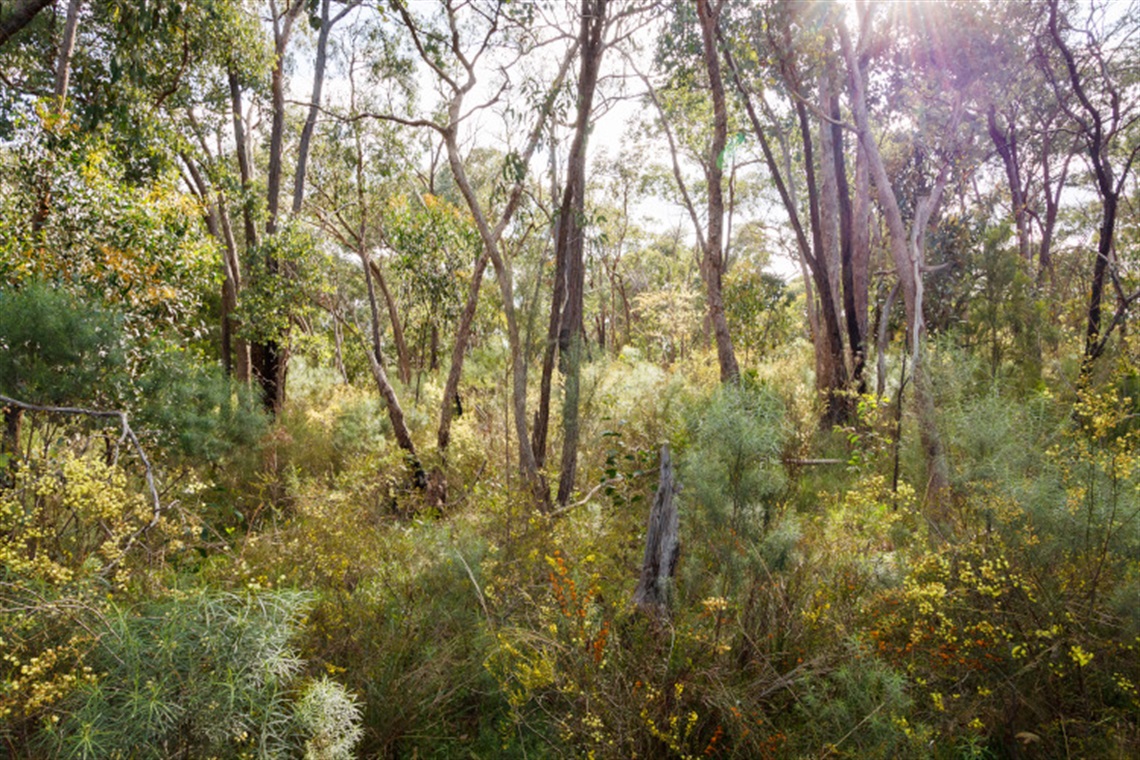St Helena Bush Reserve

This 2.4 hectare reserve has remnant indigenous vegetation, and is surrounded by urban development. The reserve is rated as one of the top five most significant sites within Banyule as it contains the highest quality example of intact red box-red stringybark box-stringybark woodland.
It has state significance for the flora present, and regional significance for the fauna that live here.
The Banyule Bushland Management Unit manages the reserve with assistance from local volunteers. If you are interested in helping out, join the Friends of St Helena Bush Reserve.
Dogs and cats are prohibited from entering environmentally sensitive park and reserve areas as designated by signs. Dogs must be under the effective control with a chain, cord or leash outside currently fenced areas.
History
Since European settlement, the reserve was degraded from weeds and pests, the formation of tracks, trampling, timber cutting and cattle grazing. The bushland has been reduced in size because of subdivision, which also means there are no effective habitat linkages to other local remnant bush land areas.
Members of the Friends of St Helena were part of a lobby group in the early 1980s that fought to protect and save as much vegetation and habitat as possible from development. The group is still active today.
Virtual tour
Flora and fauna
St Helena Bushland Reserve is of state significance because of its flora and regionally significant fauna species. There are 146 species, subspecies and recognised varieties and hybrids within the reserve. Three species are listed as rare or threatened in Victoria, and there are a number of species considered regionally vulnerable within the Greater Melbourne area.
The reserve provides habitat for a range of local wildlife including brushtail and ringtail possums, eastern blue tongue lizards, garden skinks, micro-bats and a large number of butterflies and other insects.
Fauna
| Common name |
Scientific name |
|
Australian magpie
|
Cracticus tibicen
|
|
Brushtail possum
|
Trichosurus vulpecula |
|
Common ringtail possum
|
Pseudocheirus peregrinus
|
|
Eastern blue tongue lizard
|
Tiliqua scincoides
|
| King parrot |
Alisterus scapularis |
|
Laughing kookaburra
|
Dacelo novaeguineae
|
|
Rainbow lorikeet
|
Trichoglossus moluccanus
|
|
Tawny frogmouth
|
Podargus strigoides
|
Flora
| Scientific name |
Common name |
|
Acacia acinacea
|
Gold dust wattle
|
|
Acacia genistifolia
|
Spreading wattle
|
|
Arthropodium strictum
|
Chocolate lily
|
|
Caladenia parva
|
Green-comb spider orchid
|
|
Comesperma volubile
|
Love creeper
|
|
Coronidium scorpioides
|
Button everlasting
|
|
Daviesia leptophylla
|
Narrow-leaf bitter pea
|
|
Dichondra repens
|
Kidney weed
|
|
Diuris pardina
|
Leopard orchid
|
|
Eucalyptus macrorhyncha
|
Red stringybark
|
|
Eucalyptus polyanthemos
|
Red box
|
|
Goodenia blackiana
|
Black's goodenia
|
|
Hardenbergia violacea
|
Purple coral pea
|
|
Hovea heterophylla
|
Common hovea
|
|
Microseris lanceolata
|
Murnong, yam daisy
|
|
Pterostylis curta
|
Blunt greenhood
|
|
Stackhousia monogyna
|
Creamy candles
|
|
Tetratheca ciliata
|
Pink bells
|
|
Thysanotus patersonii
|
Twining fringe lily
|
|
Wurmbea dioica
|
Early nancy
|
Location
Eskdale Court, St Helena 3088 View Map
-37.6936152,145.1380939
Eskdale Court ,
St Helena 3088
Eskdale Court ,
St Helena 3088
St Helena Bush Reserve